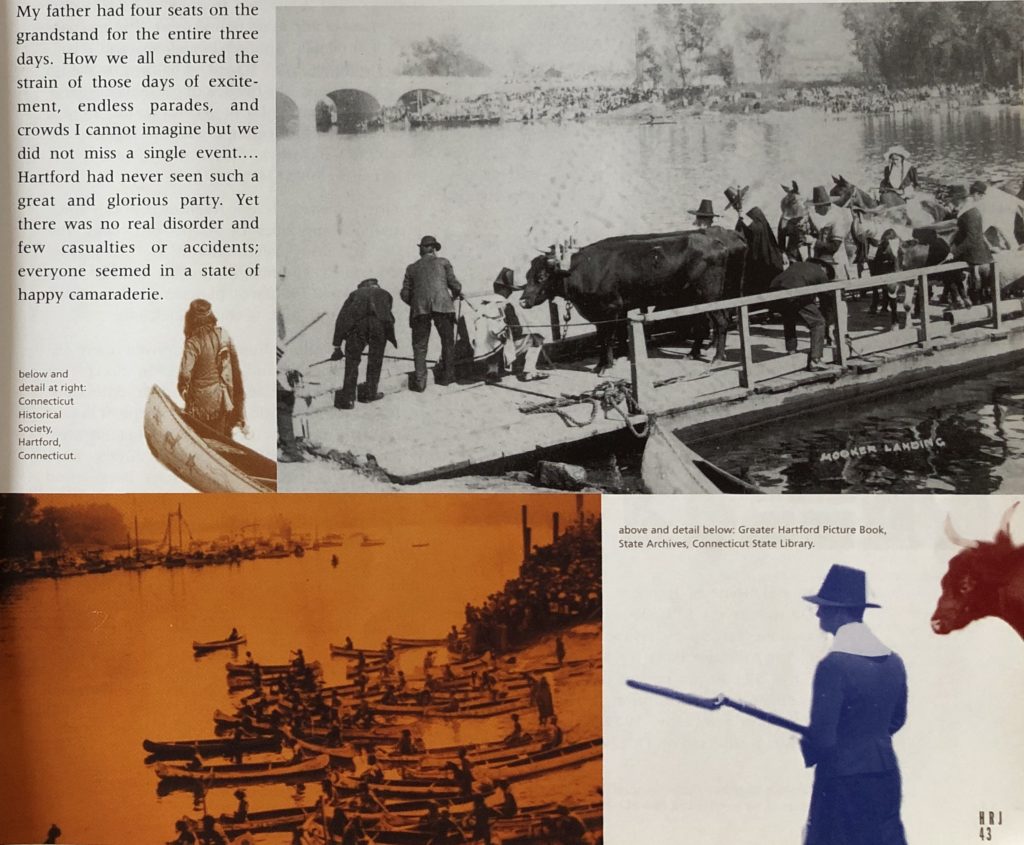From The Three Great Days
by Francis Goodwin II
(c) Connecticut Explored Inc. WINTER 2003
This passage has been excerpted from a paper delivered by Francis Goodwin II (1895 – 1976) before the Monday Evening Club of Hartford in October 1967. Founded in 1869 as a men’s literary group, members of the Monday Evening Club of Hartford have included Horace Bushnell, Hartford Courant editor Charles Dudley Warner, and Samuel Clemens (a.k.a. Mark Twain). The club is still in existence; its archives, including correspondence, membership lists, and presented papers are available at the Watkinson Library of Trinity College. This piece is published with the permission of Jane Fenwick Goodwin, the author’s daughter.
The warm misty sunlight of a midmorning in early October filtered down through a lofty canopy of elms and willows over a wide area of mud and trampled grass — grass trampled by the feet of nearly 200 milling people: men, women and children in a variety of 17th-century costume. Nearby were huddled several horses, cows, grunting pigs, goats, and a small flock of sheep. Noise, excitement, and confusion prevailed. The talk of adults was overlaid by the shouts of children and by the bleating of sheep and goats, the grunting of pigs, the lowing of a cow, or the whinney of a frightened horse. It was Tuesday, October 6, 1908, and the scene was the bank of the Connecticut River at East Hartford almost opposite the foot of Hartford’s Talcott Street. The occasion was the re-enaction [sic] of the arrival of Thomas Hooker at the culmination of his overland trek from Cambridge to Hartford in 1636, and was one of the opening events in what was to be the most ambitious, elaborate, and incredible celebration which Hartford had ever known, or has known since, or is likely to know again. Three days had been set apart to celebrate the dedication of the new stone bridge across the Connecticut River, to be known as Bulkeley Bridge in honor of the Bridge Commission’s chairman and Connecticut’s senior senator, Morgan G. Bulkeley. It seemed fitting that reenactment of Hooker’s arrival should take place on the opening day.

Images of Bridge Week, 1908. Greater Hartford Picture Book, State Archives, Connecticut State Library
Drawn up on the East Hartford bank were three or four large platform rafts specially built for the occasion. As the hour of noon approached under Walter Schutz’s guidance and encouragement the entire company was shepherded on board two rafts and paddled by a number of young men. With long sweeps the rafts were slowly propelled across the river to the Hartford shore. The animals presented more difficult problems but with the efforts of obviously experienced men the horses, cows, pigs, goats, and sheep were herded aboard and the animal rafts reached the other bank safely.
As the rafts approached the Hartford shore they were met and greeted by a crowd of half-naked, painted Indians paddling canoes, several of which were the real birch bark variety. A noisy and hectic scene on the riverbank ensued. Trinity students had been given the role of welcomers to the Hooker party and a welcome it was indeed.… It must be remembered that most of the men, particularly the Indians, had been well fortified by alcohol — in fact this general state applied to most of the adult male population of Hartford over the next three days.
Finally the animals were led away and the crowd gradually dispersed to mingle with the vast throng of spectators, which filled the Hartford shore and Connecticut Boulevard from State Street to Morgan Street…. Somehow I became separated from my family and found to my horror that I must walk home alone to Garden Street where we then lived. All trolley service in downtown Hartford had been suspended after 10 a.m. each day of the celebration. Anyway, I had no money and was dressed as a young Puritan with buckled knee breeches, little black jacket with wide white collar, and a broad brimmed, high-pointed hat. I shall never forget the pain and embarrassment of that walk from the East Side to Main Street, followed by a crowd of jeering urchins, down Asylum Street and up Asylum Hill to Garden Street.
The landing of Thomas Hooker, however, was but the merest curtain raiser to the next three days of celebration. No one who was not present or does not remember “Bridge Week,” as it was called, can possibly imagine the extent of this celebration, the enormous number of people involved, nor, as I look back on it, what [must]have been almost insurmountable problems of planning and organization.… It was an incredible undertaking. Hartford’s population at the time was barely 100,000 and the satellite towns had mere fractions of their present numbers. Yet during these three days-October 6, 7, and 8-Hartford was host to more than 200,000 visitors coming not only from Connecticut, but from many other parts of the country.
My father had four seats on the grandstand for the entire three days. How we all endured the strain of those days of excitement, endless parades, and crowds I cannot imagine but we did not miss a single event.… Hartford had never seen such a great and glorious party. Yet there was no real disorder and few casualties or accidents; everyone seemed in a state of happy camaraderie.
